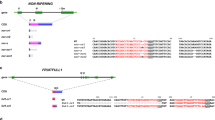Abstract
Key message
CRISPR/Cas9-edited TOMATO AGAMOUS-LIKE1 (TAGL1) provided new insights into fruit ripening.
Abstract
TOMATO AGAMOUS LIKE 1 (TAGL1) has been identified as playing a key role in the process of tomato fruit development and ripening. We have re-evaluated the functions of TAGL1 using CRISPR/Cas9 mutagenesis. Three KO mutants contained frameshift mutations resulting in premature termination codons due to a 1 bp insertion. TAGL1-KO mutants exhibited dark immature fruits and orange ripening fruits. The fruit shape was characterized by a prominent pointed tip at the end and the pericarp thickness was significantly thinner. TAGL1-KO mutants showed reduced ethylene biosynthesis, increased firmness, and delayed onset of ripening. The chlorophyll content of TAGL1-KO mutants was higher in the mature green stage and the lycopene content of TAGL1-KO mutants in the ripening stage was lower compared to the WT. ACS2, ACS4, ACO1, ACO3, PG2a, PL, PME, EXP1, and PSY1 in the mutants were significantly down-regulated during ripening. Ripening fruits in the double mutant of rin and tagl1 showed a more extreme phenotype than the rin mutant suggesting that the double mutation acts synergistically during ripening. TAGL1-targeted mutagenesis by CRISPR/Cas9 strengthens its regulatory functions controlling ripening parameters and provides new insights into fruit ripening.




Similar content being viewed by others
Data availability
Data will be made available if requested.
References
Gao Y, Wei W, Fan Z, Zhao X, Zhang Y, Jing Y, Zhu B, Zhu H, Shan W, Chen J (2020) Re-evaluation of the nor mutation and the role of the NAC-NOR transcription factor in tomato fruit ripening. J Exp Bot 71:3560–3574
Güler Z, Şekerli YE (2013) Distribution of volatile compounds in organic tomato (lycopersicon esculentum) at different ripening stages. Akad Gıda 11:6–13
Itkin M, Seybold H, Breitel D, Rogachev I, Meir S, Aharoni A (2009) TOMATO AGAMOUS-LIKE 1 is a component of the fruit ripening regulatory network. Plant J 60:1081–1095
Ito Y, Nishizawa-Yokoi A, Endo M, Mikami M, Shima Y, Nakamura N, Kotake-Nara E, Kawasaki S, Toki S (2017) Re-evaluation of the rin mutation and the role of RIN in the induction of tomato ripening. Nat Plants 3:866–874
Klee HJ, Giovannoni JJ (2011) Genetics and control of tomato fruit ripening and quality attributes. Annu Rev Genet 45:41–59
Lee JM, Joung JG, Mcquinn R, Chung MY, Fei Z, Tieman D, Klee H, Giovannoni J (2012) Combined transcriptome, genetic diversity and metabolite profiling in tomato fruit reveals that the ethylene response factor SlERF6 plays an important role in ripening and carotenoid accumulation. Plant J 70:191–204
Liu G, Li C, Yu H, Tao P, Yuan L, Ye J, Chen W, Wang Y, Ge P, Zhang J, Zhou G, Zheng W, Ye Z, Zhang Y (2020) GREEN STRIPE, encoding methylated TOMATO AGAMOUS-LIKE 1, regulates chloroplast development and Chl synthesis in fruit. New Phytol 228:302–317
Vrebalov J, Pan IL, Arroyo AJM, Mcquinn R, Chung M, Poole M, Rose J, Seymour G, Grandillo S, Giovannoni J (2009) Fleshy fruit expansion and ripening are regulated by the tomato SHATTERPROOF gene TAGL1. Plant Cell 21:3041–3062
Wang R, Angenent GC, Seymour G, De Maagd RA (2020) Revisiting the role of master regulators in tomato ripening. Trends Plant Sci 25:291–301
Yoo HJ, Chung MY, Lee HA, Lee SB, Grandillo S, Giovannoni JJ, Lee JM (2023) Natural overexpression of CAROTENOID CLEAVAGE DIOXYGENASE 4 in tomato alters carotenoid flux. Plant Physiol 192:1289–1306
Acknowledgements
This work was supported by the National Research Foundation of Korea grant funded by the Korea government (MSIT) (2021R1A2C2093789). Authors would like to thank Dr. Sang-Tae Kim and Hyerim Do for their technical support.
Funding
National Research Foundation of Korea, 2021R1A2C2093789, Je Min Lee
Author information
Authors and Affiliations
Contributions
MYC and JML designed the research. CJ and MYC performed the experiments. CJ and JML analyzed the data and wrote the manuscript.
Corresponding author
Ethics declarations
Conflict of interest
The authors declare no competing financial interests.
Additional information
Communicated by Neal Stewart.
Publisher's Note
Springer Nature remains neutral with regard to jurisdictional claims in published maps and institutional affiliations.
Supplementary Information
Below is the link to the electronic supplementary material.
Rights and permissions
Springer Nature or its licensor (e.g. a society or other partner) holds exclusive rights to this article under a publishing agreement with the author(s) or other rightsholder(s); author self-archiving of the accepted manuscript version of this article is solely governed by the terms of such publishing agreement and applicable law.
About this article
Cite this article
Jeon, C., Chung, MY. & Lee, J.M. Reassessing the contribution of TOMATO AGAMOUS-LIKE1 to fruit ripening by CRISPR/Cas9 mutagenesis. Plant Cell Rep 43, 41 (2024). https://doi.org/10.1007/s00299-023-03105-7
Received:
Accepted:
Published:
DOI: https://doi.org/10.1007/s00299-023-03105-7




